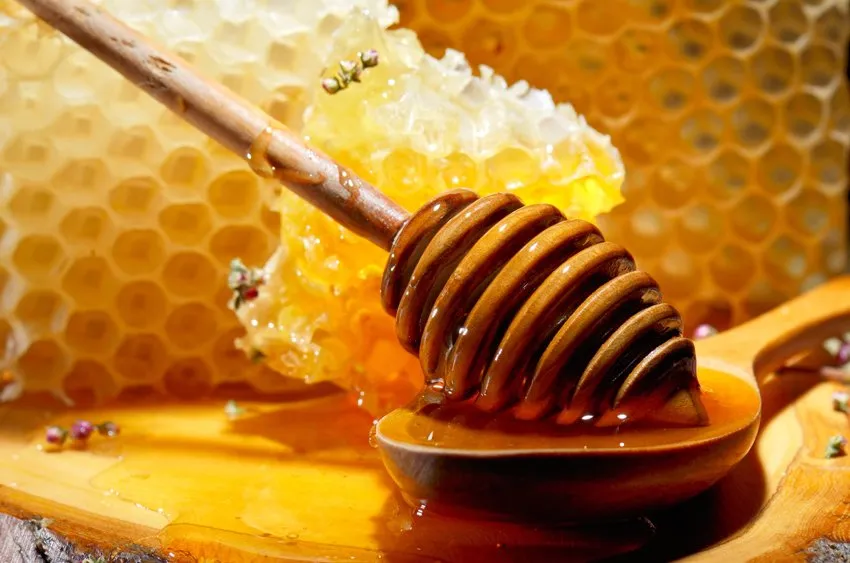
Today we will talk about honey, and in particular about acacia, chestnut or millefiori honey and its properties. Honey is a very precious food, produced by the working activity of bees and other species of hymenoptera, starting with nectar and honeydew. The honeydew is a sugar secretion emitted by most of the Omoptera that feed on the sap of plants; the nectar is also a sugary liquid produced by the inflorescences of plants to attract pollinating animals such as bees.
The localization of the nectars on the various cultivars of flowers and of tree species varies from genusbotany and is usually distinguished in floral and extra-flower nectars, which are located in non reproductive parts of the plant. The nectar is botted, i. e. produced by bees that complete the production and processing cycle into honey.
Honey is partly used as feed by bees and partly transformed into beeswax to build the famous hexagonal cells. Honey is economically important and constitutes the "core" business of the agricultural-entrepreneurial activity of beekeepers, who produce and distribute the various types of honey on local and international markets.
Honey properties: A food product that has been highly appreciated since ancient times
Honey consumption has been replaced and, to some extent, supplanted by today's use of white sugar, cane sugar and all the chemical and synthetic sweeteners that the sugar industry has put on the market.
In the past, honey has had better times due to its fame and success, which has always been a success since ancient times.
Since the beginnings of mankind, honey has been the only concentrated sugary food, the first traces of which date back to the VI millennium BC. The etymology of the term honey comes from the word' melit'. In ancient Egypt honey was highly appreciated, considered the food of the gods, pots filled with honey were found in the tombs of Pharaohs.
The Sumerians began to produce honey for therapeutic purposes: in cream mixed with clay, water and cedar oil. Ayurvedic medicine also considered honey as purifying, aphrodisiac, thirst-quenching, vermifuge and antitoxic. The Greeks and Romans used honey as a sweetener and preservative for sweet and sour foods. From the Middle Ages to the Modern Age, honey was gradually replaced after the introduction of industrially refined sugar.
Properties and benefits of Honey
Honey is a product that, as we have already had the opportunity to anticipate, is highly appreciated for its well-known nutritional and beneficial properties. It takes on a natural remedy function to fight infections and protect the body from the action of harmful bacteria and microorganisms that can weaken the immune defences of the human body.
Honey is considered a natural antibiotic that heals wounds, abrasions, burns and coughing, whooping coughing and alleviates any flu symptoms.
Powerful anti-inflammatory and antioxidant, honey is rich in polyphenols that help to fight free radicals and protect the health of the heart and the entire cardio-vascular system.
Honey of Acacia, chestnut or millefiori honey: the benefits on the body of these varieties
The honey product is a food that has various antibacterial, nutritional, nutritive and cosmetic properties; it is a natural food that provides energy, thanks to its richness in carbohydrates and, depending on the variety, it is possible to distinguish the intrinsic benefits and organoleptic characteristics. Among the best known and appreciated by the gourmets' palate are acacia honey, with a very delicate, velvety flavor and a sweet aftertaste.
From an organoleptic point of view, acacia honey is light and transparent in color. The main production area comprises the pre-Alpine areas of Lombardy, Piedmont and Veneto.
This honey is excellent for relieving sore throat, acidity of the stomach and other digestive tract pathologies. Thanks to the laxative effects it can also be useful to combat constipation and is the most recommended for diabetics, as it is rich in fructose.
Another very appreciated honey is chestnut: it has a variable color ranging from light walnut to dark walnut and a very strong taste, almost acrid. It is cultivated in the hilly, premontan and Apennine areas, from the Alps to Sicily. Its consumption is recommended in all cases of bad blood circulation: this is also recommended for anaemic and fatigued people. Chestnut honey is very astringent and disinfectant in the urinary tract.
The honey market offers another highly appreciated variety: the multi-flower or multi-flower honey, whose denomination derives from the quantity of pollen. Within the category of wildflower honeys one must distinguish:
plain floral millefiori honey, whose color is clear and transparent, whose pollens are those of clover, alfalfa, rape and dandelion. They are honey with a delicate taste, suitable for culinary and non-medical use;
the mountain wildflower honey, with a more brownish color and intense acrid olfactory notes, suitable for therapeutic uses.
We remind you that the nutritional properties of millefiori are higher than those of other honeys, because they contain a large amount of pollen. That's why it's great for children and coughing as a natural remedy. About 100 grams of this honey make 300 kcal, being a product made of 80% sugar (fructose).